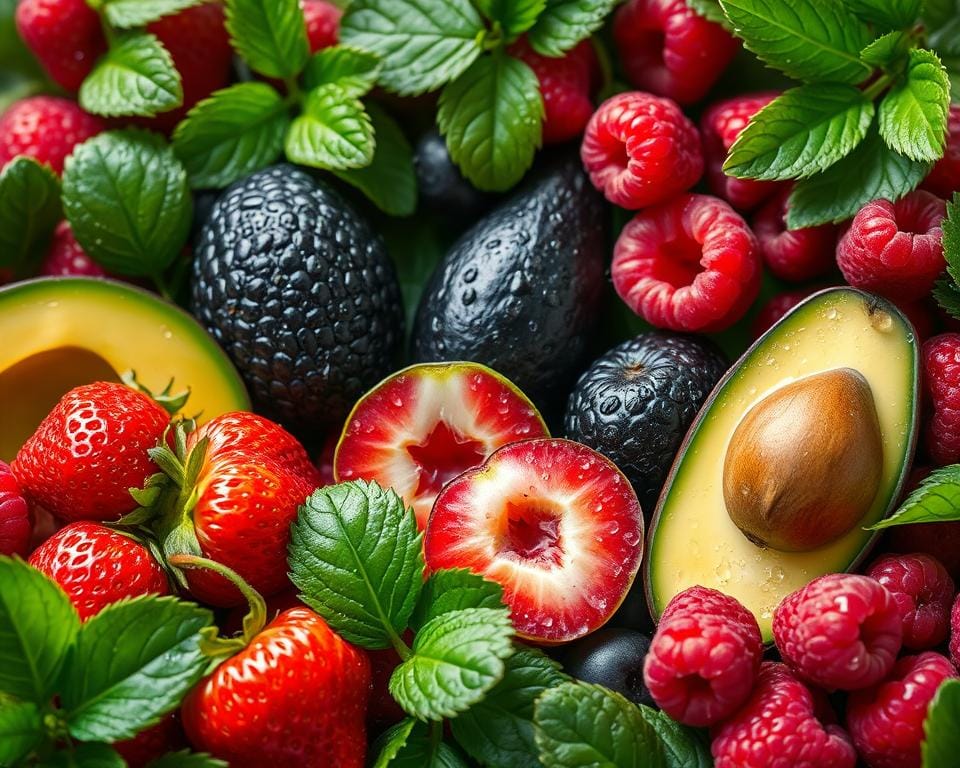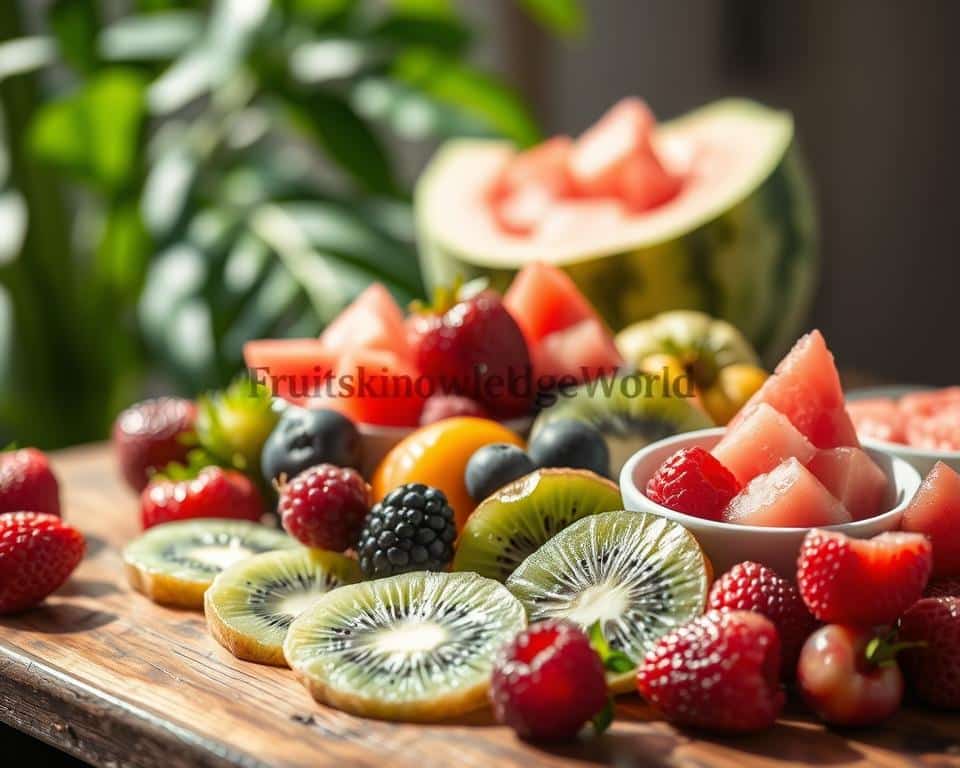Going for a balanced diet? Then you’ll look at the sugar in your meals, especially fruits. Fruits are packed with good stuff like vitamins and minerals. But, their sugar levels differ a lot. That’s where low-sugar fruits come in. Think lemons, limes, raspberries, and blackberries. These options are great for those watching their sugar or dealing with diabetes. Plus, they’re loaded with nutrients and fiber, minus the high sugar.
Key Takeaways
- Low-sugar fruits offer numerous health benefits without spiking your sugar intake.
- Citrus fruits like lemons and limes have minimal sugar but provide a good dose of vitamin C.
- Berries like raspberries and blackberries are excellent choices for a low-sugar diet.
- Including low-sugar fruits in your daily diet can help manage health conditions like diabetes.
- Choosing low-sugar fruits allows you to enjoy the sweetness of nature without the extra calories.
Understanding the Benefits of Low-Sugar Fruits
Today, many people want to cut down on sugar in their diets. They know that too much sugar can lead to weight gain, diabetes, and heart disease. Choosing low-sugar fruits is a good step towards a healthier diet.

Why Reduce Sugar Intake?
Less sugar means better health. Added sugars in processed foods are linked to health risks like obesity and metabolic issues. Low glycemic index fruits don’t spike your blood sugar much, making them a smarter choice.
Natural Sugars vs. Added Sugars
It’s important to know the difference between natural and added sugars. Natural sugars come from fruits and dairy and are good for you. They give you fiber, vitamins, and minerals. But added sugars are just empty calories that can harm your health. For more on sugar types and health effects, check out this guide on natural versus added sugars.
Health Benefits of Low-Sugar Fruits
Low-sugar fruits are tasty and full of nutrients that help you stay healthy. Take raspberries, for example, they have only 2.7 grams of sugar per half-cup and 4 grams of fiber. This helps control blood sugar and lowers the risk of heart disease and cancer.
To manage your sugar intake, pick fresh fruits over dried ones or smoothies. Adding low-sugar fruits to meals with fat, protein, or fiber can also help avoid blood sugar spikes. This way, you get more health benefits.
Top Low-Sugar Fruits to Include in Your Diet
Looking to reduce sugar while still enjoying tasty, nutritious foods? These low-sugar fruits are a great choice. They cut your sugar intake and boost your health.

Citrus Fruits: Lemons and Limes
Citrus fruits like lemons and limes are low in sugar and high in vitamin C. A lime has just 1 gram of sugar. They’re great in water, salads, and marinades. They add flavor without extra sugar. Their antioxidants also help improve your health and immune system.
Berries: Raspberries, Strawberries, and Blackberries
Berries like raspberries, strawberries, and blackberries are full of nutrients. Raspberries have only 5 grams of sugar per cup and lots of fiber and antioxidants. Strawberries and blackberries have a bit more sugar, but not much. Blueberries have more sugar but are still healthy. You can add these berries to many foods to keep sugar low and flavor high.
Other Low-Sugar Fruits: Kiwis, Avocados, and Grapefruit
Kiwis, avocados, and grapefruit are also great low-sugar options. Kiwis have 7 grams of sugar and lots of fiber and vitamin C. Avocados are unique with less than half a gram of sugar and lots of fiber. They’re great for heart health. Grapefruit has a little more sugar but is full of vitamins. It’s a refreshing way to start the day.
Add these low-sugar fruits to your diet. They help balance your nutrients while keeping sugar under control.
| Fruit | Grams of Sugar | Benefits |
|---|---|---|
| Raspberries | 5 g per cup | High in fiber and antioxidants, low in calories |
| Strawberries | 7 g per cup | Rich in vitamins, antioxidants, and fiber |
| Blackberries | 7 g per cup | Low in calories, high in fiber, vitamins, and minerals |
| Kiwis | 7 g per fruit | Contains carotenoids, fiber, and vitamin C |
| Avocados | 0.5 g per fruit | Rich in healthy fats and fiber, promotes satiety |
| Grapefruit | 11 g per half fruit | High in vitamins A and C, supports the immune system |
Sugar Content in Fruits: A Detailed Look
It’s key to know the sugar in fruits for good glucose control and a healthy diet. Fruits vary in fruit sugar levels. This affects your diet’s nutritional value. Let’s examine common fruits and their sugar amounts.
| Fruit | Sugar Content (grams per serving) |
|---|---|
| Apples | 25.1 |
| Bananas | 15.4 |
| Cherries | 19.7 |
| Grapes | 14.9 |
| Mangoes | 46 |
| Oranges | 17.2 |
| Pears | 17.4 |
| Pineapple (chunks) | 16.3 |
| Watermelon (diced) | 9.42 |
Looking at the sugar per 100 grams offers insights. For example, watermelon has about 9 grams of sugar. It includes 3.3 grams of fructose. Conversely, raisins have 65 grams of sugar per 100 grams. This shows that drying fruits increases sugar concentration.
When we talk about fruit’s nutritional value, consider more than sugar. Fruits bring vitamins, minerals, fiber, and antioxidants. These benefits can balance the natural sugars if you eat them in moderation. For those with conditions like diabetes, picking fruits with less sugar—like avocados (0.9 grams) and strawberries (5.8 grams)—helps manage glucose control better.
Delicious Ways to Enjoy Low-Sugar Fruits
Adding low-sugar fruits to your daily diet is both enjoyable and healthy. They can make breakfasts tasty and snacks satisfying. These fruits bring flavor and help you keep a balanced diet. Let’s explore how to include them in your day.
Breakfast Ideas
Start your day with something refreshing and healthy. You might enjoy a yogurt parfait with raspberries or strawberries. They’re low in sugar. Alternatively, use limes or lemons in your water. It wakes you up and gets you ready for the day.
Another great choice is oatmeal with blackberries or guava. These fruits add sweetness and are full of fiber. Fiber helps keep your blood sugar stable.
Lunch and Dinner Recipes
Add low-sugar fruits to your lunch and dinner for a tasty twist. Try a salad with avocado and grapefruit, dressed in a light vinaigrette. These fruits are flavorful without adding too much sugar.
For something filling, try grilled chicken with kiwi salsa. The kiwi’s tang enhances the chicken’s savory taste. Adding rhubarb to stews or apricots to grain bowls offers a sweet touch.
Snacking Tips
Choose healthier snacks by going for low-sugar fruits. Pieces of melon or blueberries are refreshing and curb sugar cravings. They’re a perfect snack choice.
Try a cup of fresh cranberries or blackberries too. They’re high in fiber, which helps you feel full and supports digestion. Making snack packs with different fruits can help with your fruit meal planning.
Having a range of healthy fruit recipes makes following a low-sugar diet easier and more fun. By smartly using low-sugar fruits in meals and snacks, you can enjoy tasty foods while caring for your health.
Conclusion
Choosing a sugar-wise diet is a big step toward eating healthier. Adding low-sugar fruits to your meals means you’re picking fruits smartly. You won’t lose out on taste or health benefits.
Research shows that eating too much added sugar can lead to heart disease. It also shows the bad effects of sugary drinks on our health. This research teaches us to be careful about how much sugar we eat.
By understanding the sugar in fruits, we can choose better. Some fruits, like peaches, have less sugar than others, like grapes. This knowledge helps us pick what’s best for our health.
Knowing how different fruits affect our bodies is key. It helps us see why some fruits are better for us. This makes them tasty and good for our health.
Eating fruits with less sugar is good for us and follows global health advice. It’s about eating right and making our food taste good. Paying attention to how much and how we prepare it can make our eating healthier.
Fruits are great for us when chosen wisely. They offer amazing flavors and health benefits. This helps us stay healthy while enjoying what nature offers.



